Don’t let its sting scare you away, the stinging nettle packs a powerful nutritional punch and is a tasty addition to many recipes. Use it in this delicious stinging nettle smoothie to reap its benefits without getting stung!
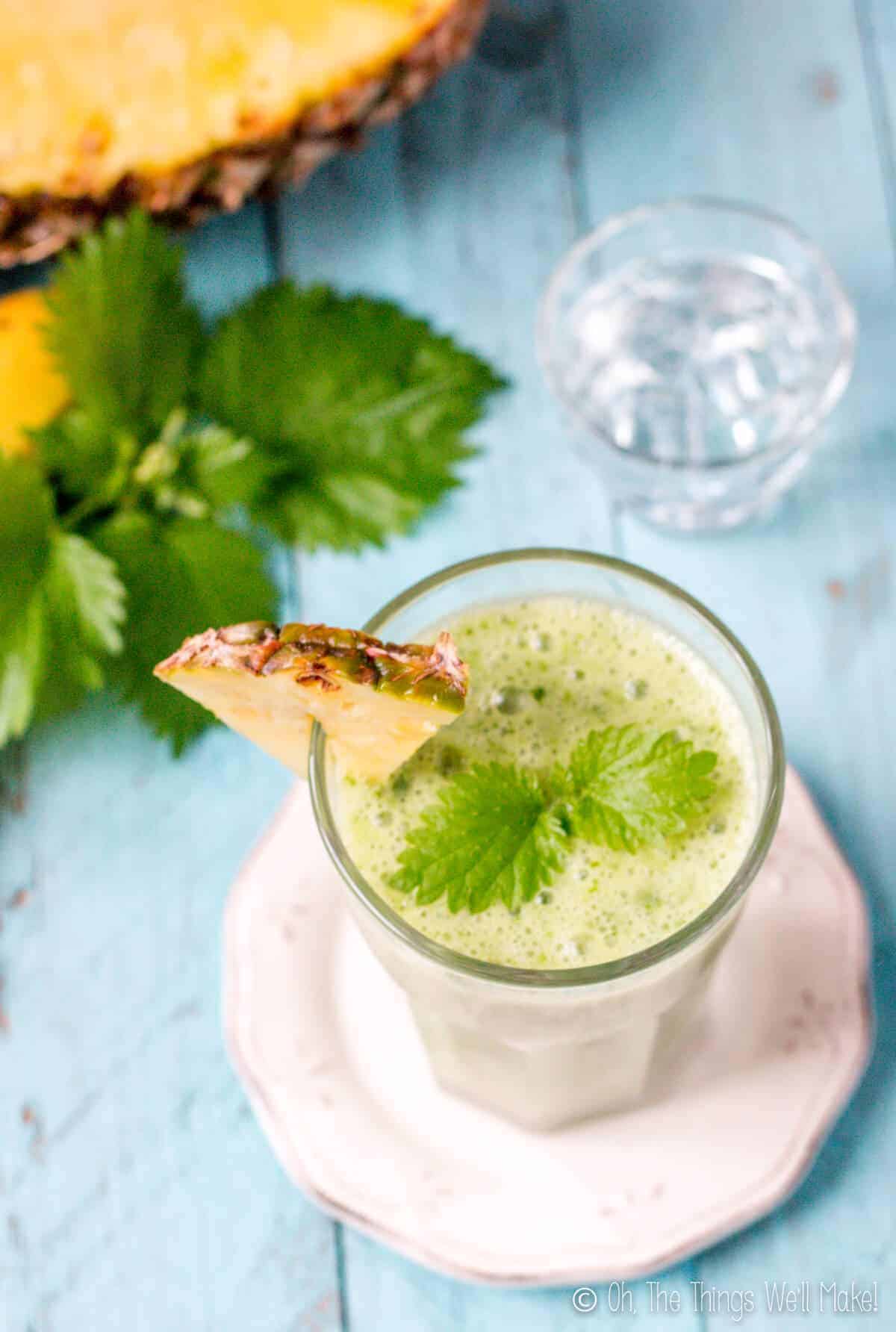
A lot of you are probably going to think that I’m crazy by making a stinging nettle smoothie, but I think after you read a bit more, you’ll be wanting to try it yourself!
Why try this?
Smoothies are a great place to sneak in veggies and other nutritious foods that are “harder” to eat. I have often added spinach to my son’s smoothies so that he gets an extra dose of veggies. At first, I snuck it in, but now he knows about it and has no problem drinking his “Popeye smoothie“.
While I love the idea of adding raw greens to my smoothies when possible, lately I’ve been hearing conflicting information about adding certain raw greens to your diet. (It has to do with oxalate content. More about that in a minute…)
The nettle, however, may be an exception. Drinking a nettle smoothie may be the ideal way to add these nutrients to your diet without the same drawbacks.
Health benefits of nettle
Nettles are considered a less well-known superfood by many. They are high in vitamins A, C, and K and also rich in bioavailable calcium. They’re low in calories and high in fiber. (Source)
Not only do they add antioxidants, tannins, polyphenols, and carotenoids to your diet, but they may help with arthritis, rheumatism, and, potentially, cancer prevention. (Source)
20+ Surprising Ways to Use Stinging Nettles
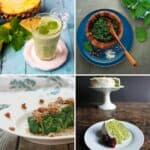
Are raw greens healthy?
Most raw greens are packed with beneficial vitamins and antioxidants as well as being low in calories and high in fiber. So, you’d think it would be best to get as many as you can into your diet.
That may not be true for everybody, though…
Cruciferous vegetables and the thyroid
Greens from the cruciferous vegetable category such as kale, cabbage, bok choy, and broccoli greens have goitrogens that can negatively affect your thyroid if you have an underlying problem and don’t get enough iodine in your diet. Cooking those foods can reduce their goitrogenic potency.
When people with thyroid issues consume too many raw cruciferous vegetables, they can block the enzymes that allow iodine to be used by the thyroid, suppressing its ability to function correctly.
Oxalates and kidney stones
Recently, more people are aware of the fact that many greens that are commonly used in raw, green smoothies are high in oxalic acid, aka. oxalates.
Spinach, chard, beets, and rhubarb are amongst the list of foods high in oxalates.
For what is probably the majority of people, drinking green smoothies with high oxalate ingredients probably isn’t going to be a huge problem, especially if you rotate your greens.
On the other hand, quite a few people are sensitive to oxalates and can develop kidney stones. Those who need to eat a diet low in oxalates may want to try using raw nettle in their smoothies instead!
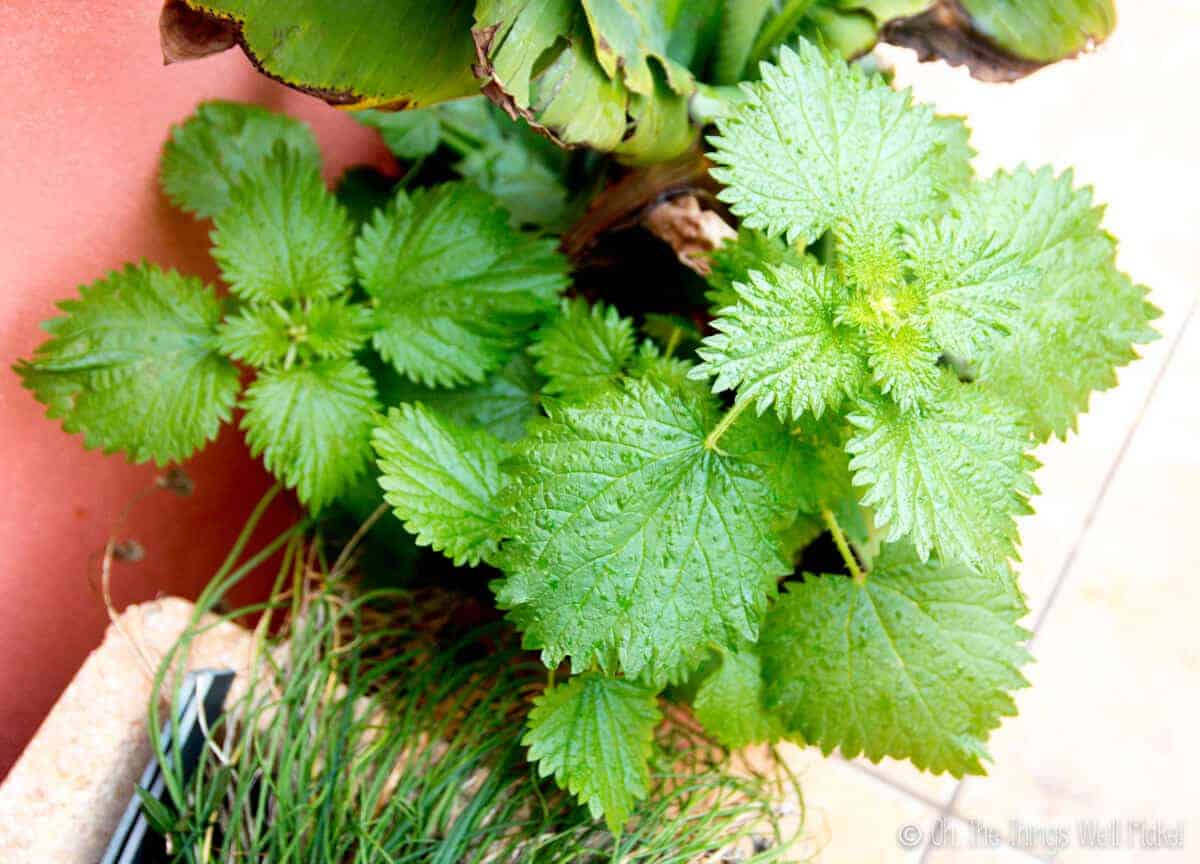
Are nettles high in oxalates?
While there seems to be conflicting information about the concentration of oxalates in the nettle leaves themselves, nettle tea is generally on the list of foods that can be consumed by those on a low oxalate diet.
Rather than aggravating or causing kidney stones, stinging nettle can actually help prevent and even dissolve kidney stones (and gout by the same mechanism)! Nettle extract decreases elevated levels of calcium, oxalate, and creatinine in urine. It also significantly decreased the amount of calcium and oxalate and calcium oxalate crystals deposited in the kidneys of test rats.
While it’s true that raw nettle may behave differently, I haven’t been able to find any information that would make me think that nettles would be harmful to those on a low oxalate diet. All of the information I’ve found seems to point to quite the opposite.
The calcium in many leafy greens (particularly spinach, chard and beet greens) is not as bioavailable to the body, due to the natural presence of high levels of oxalic acids before cooking, but Nettles do not contain much of these oxalates. Nettles actually remove oxalates from tissues throughout the body.
Dr. Mary Bove, N.D., Gaia Herbs Medical Educator and Scientific Advisory Board Member
Advice
When in doubt, you should always consult with your doctor before introducing new foods into your diet. Each person should try to make informed decisions about what foods will be best for them.
Just because I feel great drinking nettle smoothies doesn’t mean that they will be great for you!
How to harvest stinging nettles
The tricky part of working with nettle plants is harvesting them and cleaning them without irritating your skin. I’ve gone more in-depth about how to harvest nettles and their health benefits in my post with 20+ nettles recipes.
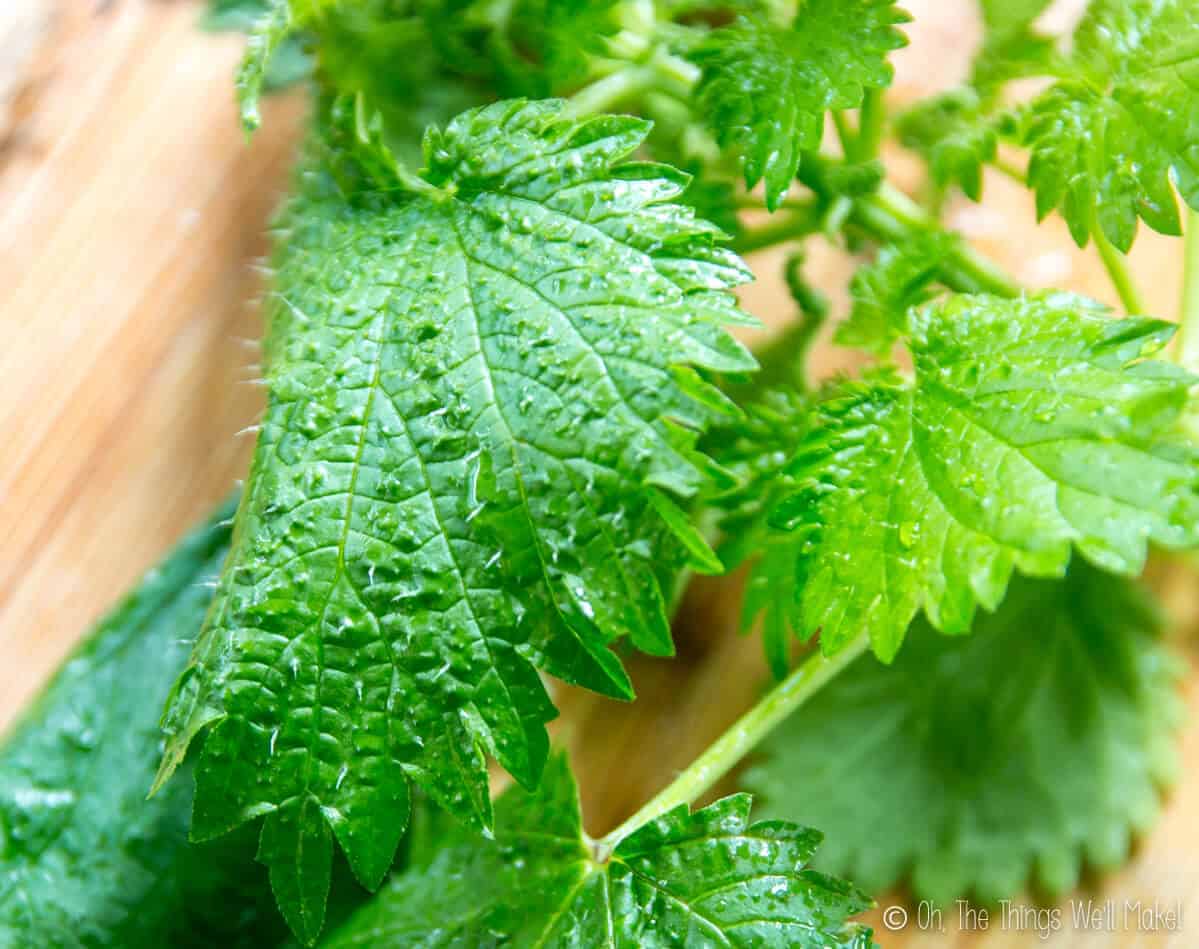
That said, I’ll give you some quick, general guidelines…
Choosing the plants
It’s best to use young plants with small leaves. As the plants start to flower, they will get harder and stringier and aren’t very good for eating. I like to harvest the top of the plants, cutting the tops off with scissors.
Protecting your hands
Pick the plants carefully. You can wear gloves to protect your hands.
When I harvest the nettles, I usually let them sit around for several hours before I clean and handle them. By letting the nettle plants wilt, the needles no longer have the strength to pierce your skin and sting you. When wilted enough, you can handle the plants without any irritation.
Once they have wilted, I proceed to rinse them several times before drying them out in a salad spinner.
If you want to use them right away, wear gloves when working with them. You can also carefully smash the needles with a spatula or the side of a large knife. Once the needles have been smashed, they will no longer sting you.
Once clean, you can use the leaves, as is, in smoothies, or in a number of other raw or cooked nettle recipes. You can also either dehydrate them for use in herbal teas, or you can freeze them for future use. (I blend them into a puree and freeze them as I freeze fruit for smoothies.)
Keep it from stinging
The stinging nettle will no longer sting you if you do any of the following:
- Cook it
- Crush the needles
- Let it wilt enough
- Dehydrate it
- Blend it into a sauce/paste/smoothie
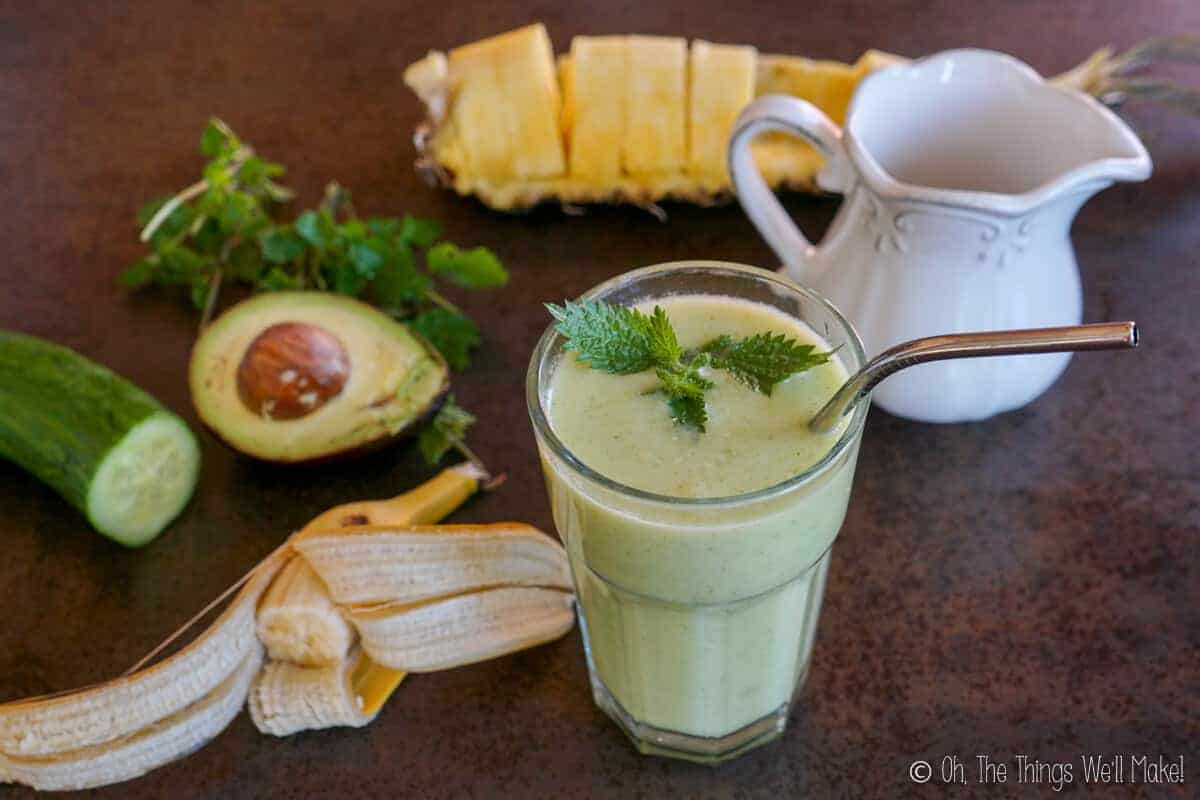
Making a stinging nettle smoothie
So, one of the best, most delicious ways to use nettles raw is to blend them into a smoothie. In this case, I’ll show you my son’s favorite, a tropical stinging nettle smoothie with pineapple, coconut milk, and banana. He was afraid to try it at first, because he’s been stung more than once by nettles in the garden, but now he loves it!
Ingredients
To make a delicious smoothie, you can really add the plant to any combination of fruits and vegetables that you like.
Because my son and I really enjoy tropical fruit smoothies, those that evoke visions of sipping a piña colada on the beach, I chose a combination of coconut milk with pineapple as the base of this smoothie. Those are the main two ingredients that we always add to tropical smoothies.
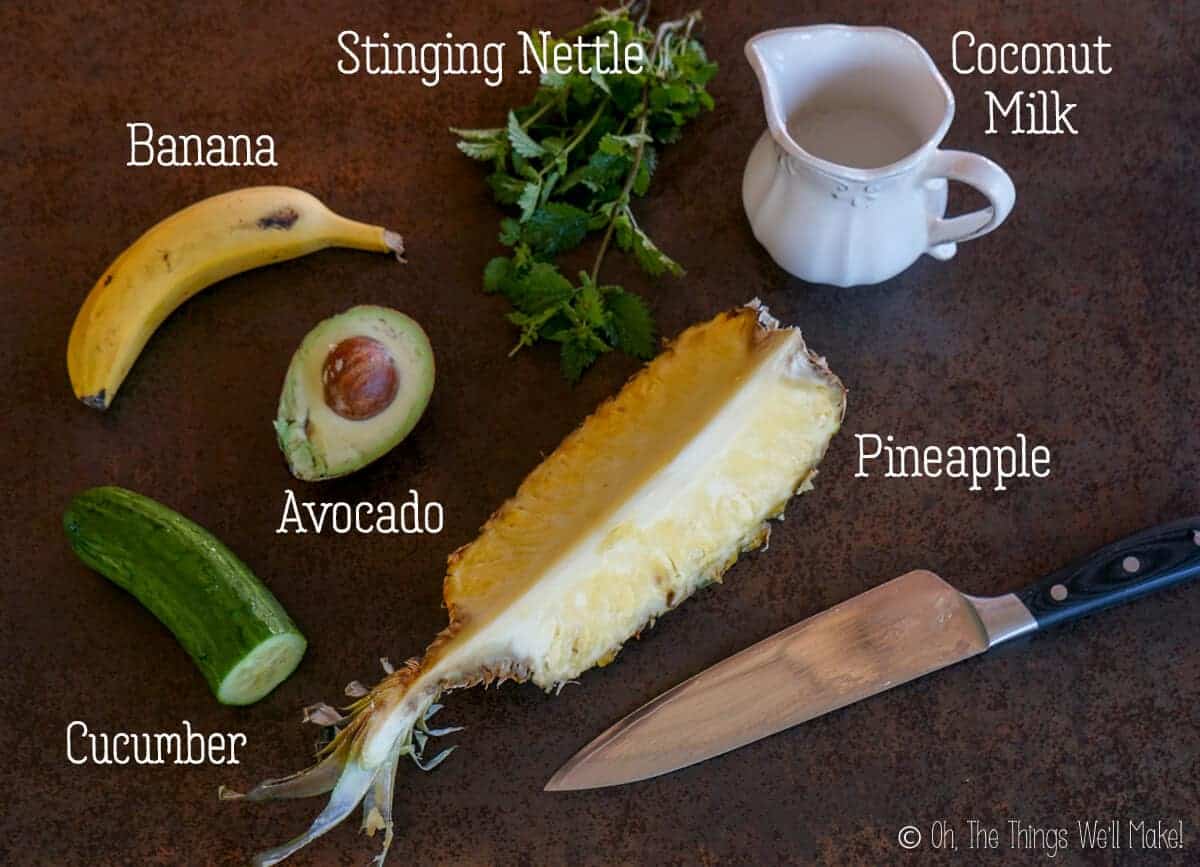
Customizing the recipe
While you could easily make a tropical nettle smoothie with only pineapple, coconut, and nettles, there are ways to make this. The other ingredients can be customized to suit your taste.
Adding cucumber
Cucumbers add bulk to the smoothie to fill you up. They’re refreshing and low in calories and sugar. I usually add half of a peeled cucumber to the smoothie. (While you could add it with the peel, it adds a gritty texture I prefer to avoid.)
Avocado
By adding avocado, you add a dose of healthy fats as well as adding creaminess to the smoothie. I usually add half an avocado to this recipe.
Bananas and/or for sweetness
If you have a sweet tooth, but don’t want to add sugar or other sweeteners to the smoothie, try adding some banana. Bananas are very sweet and naturally add their sugars to the smoothie. It’s a great use of bananas that are starting to get a bit too ripe.
Mango is another delicious optional addition to tropical drinks like this one. If using ripe mangoes, it also adds sweetness to the overall smoothie.
Tips for getting the perfect consistency
I like my smoothies to be cold, thick, and creamy. There are a few steps you can take to get the consistency you want, though!
Blend thoroughly!
To ensure a creamy smoothie, the blender you use can make a huge difference. Powerful blenders work best, of course, but blending for longer periods of time can also help.
Blend for up to a full minute at the highest setting to really break down the tiny pieces of fruit into a smooth puree. Also, avoid adding the peels of cucumbers and other hard foods like coconut that may give a gritty texture.
To help the blender work well, add liquids first, followed by the nettles (or other greens), followed by the fruit.
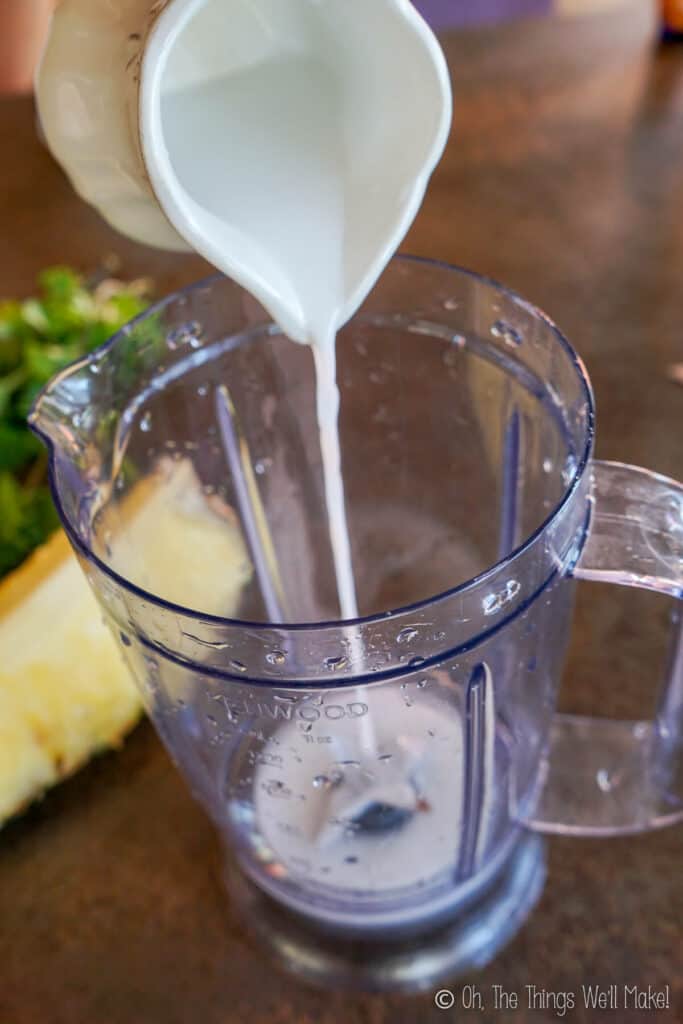
Add liquids first. 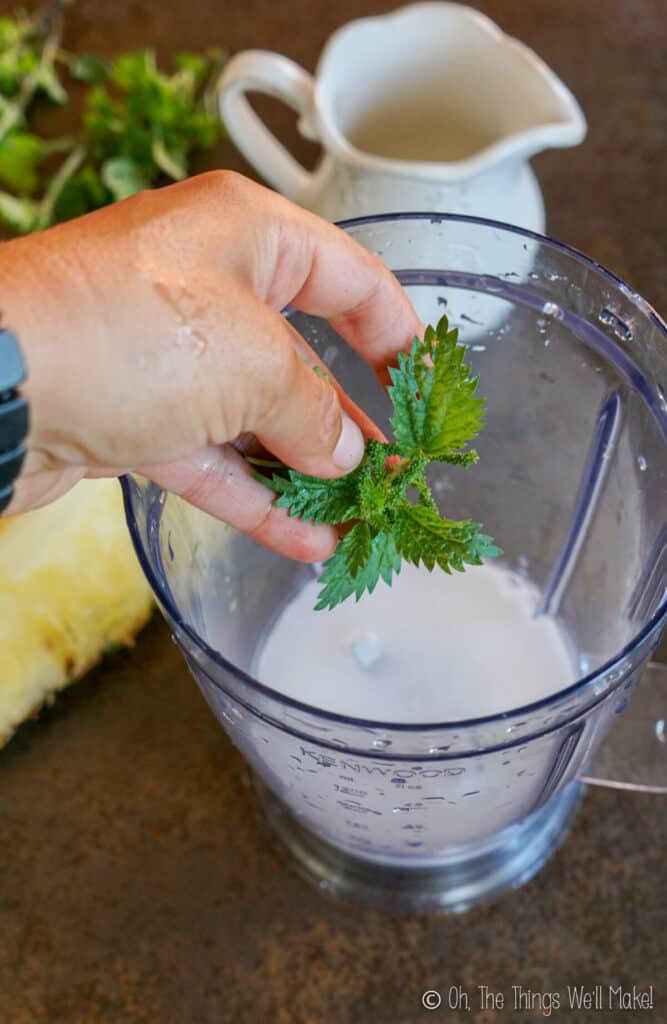
Add greens next. 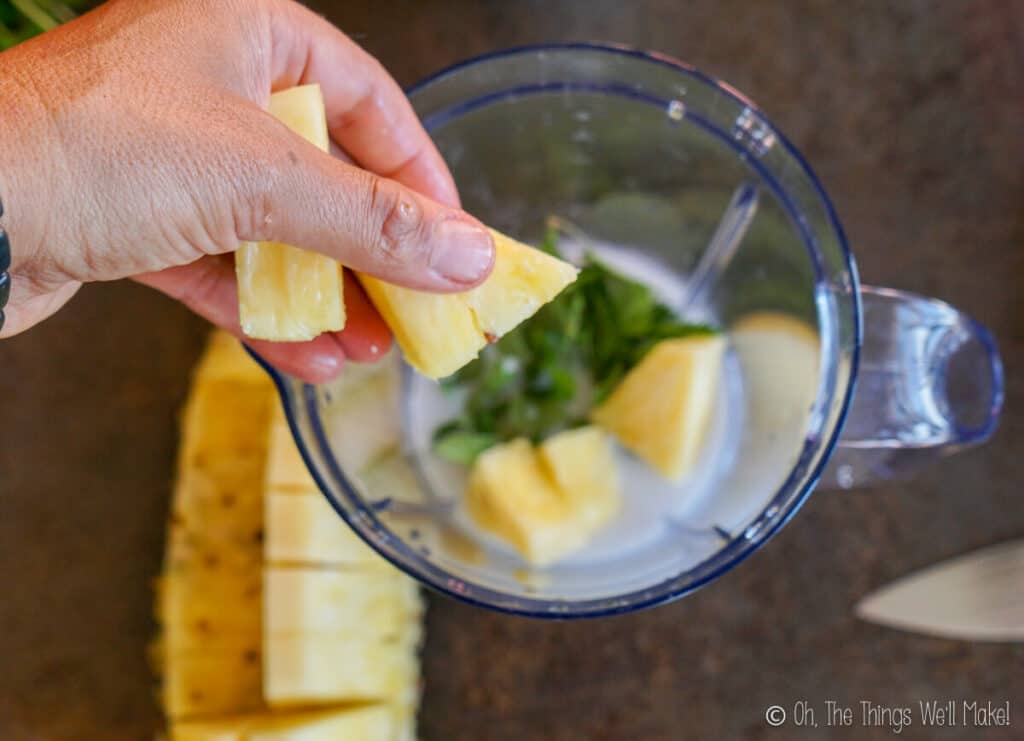
Add pineapple 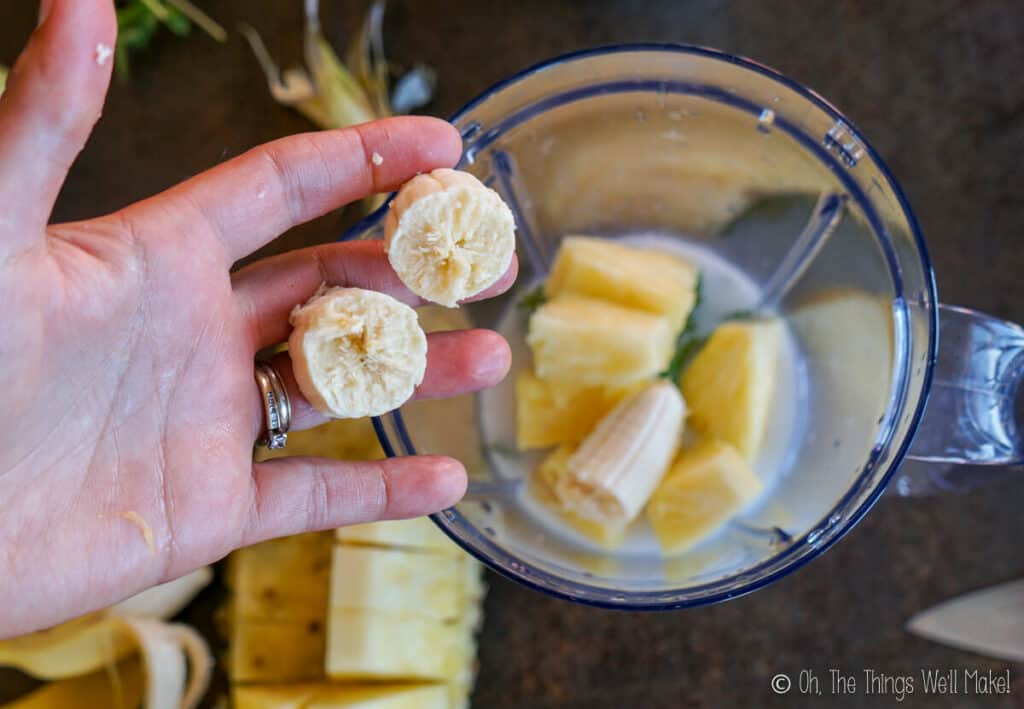
and other fruits. 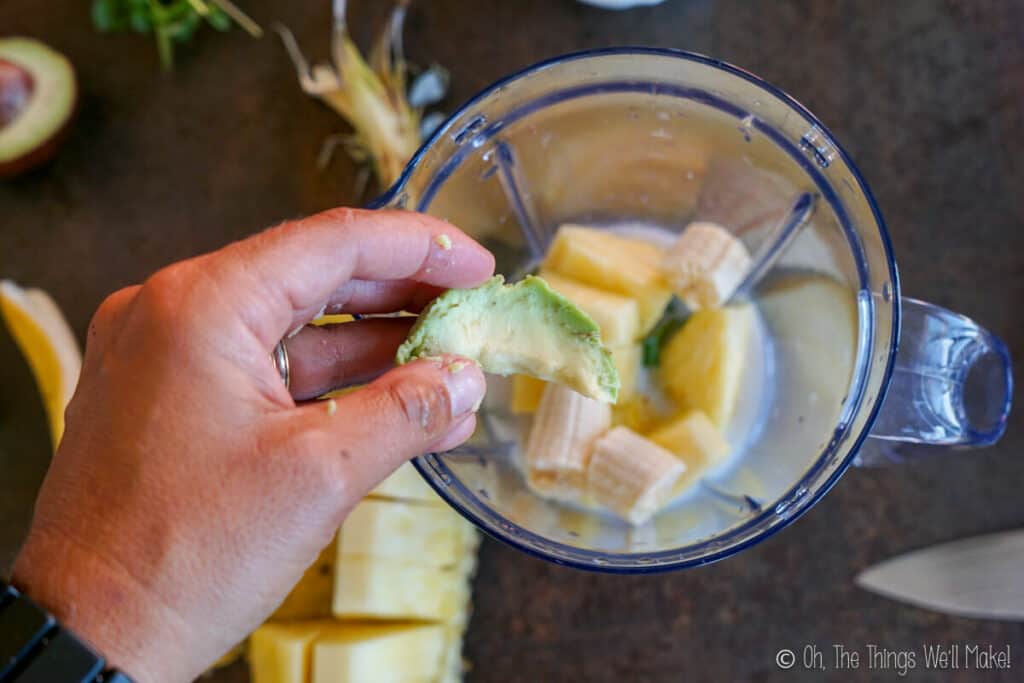
Add avocado for creaminess. 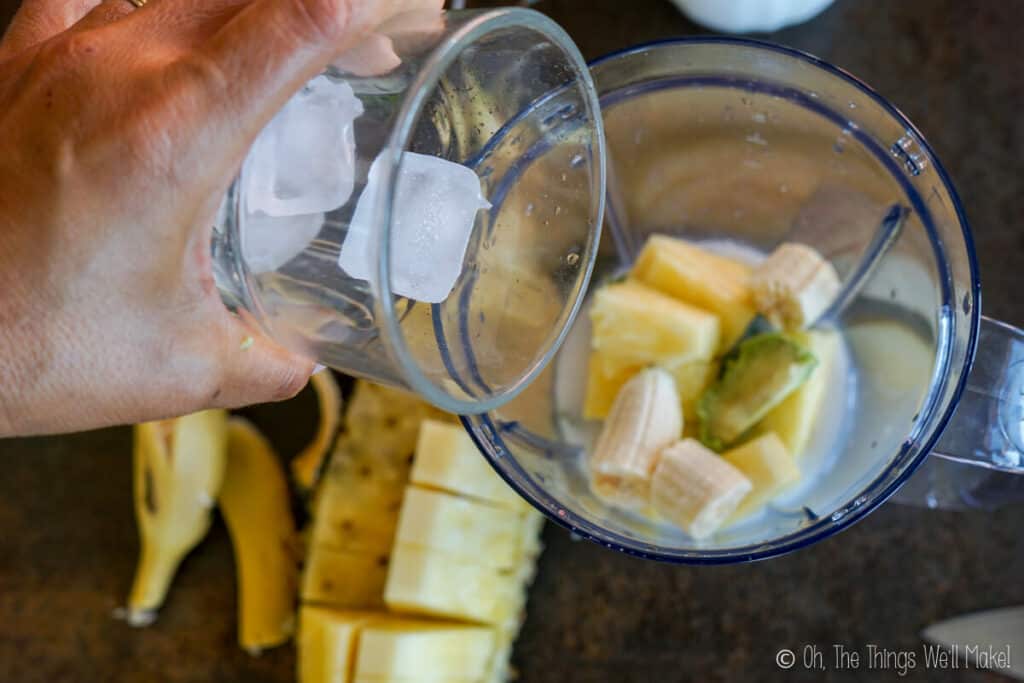
Add ice last. 

Blend thoroughly.
Add creamy ingredients
Adding avocado to the smoothie helps add creaminess. Bananas and other soft ingredients also make the puree nice and smooth.
Making it thicker or thinner
For a thicker smoothie, use less liquid, in this case, coconut milk. Following the same logic, to thin out the smoothie, add more coconut milk or water.
You can also thicken it up by using frozen fruit or by adding ice. In this recipe, it’s easy to use frozen pineapple chunks and/or pre-freeze some banana slices.
I often make “smoothie cubes” from pureed avocados or other fruits when I can get them inexpensively and in season. That way I can save money and use them year-round. Check out my tips for freezing fruits for smoothies or baby food in that way that optimizes room in the freezer.
Watch me make it
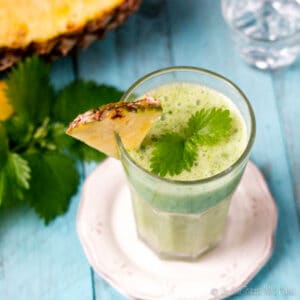
Foraged, Tropical, Stinging Nettle Smoothie
Equiment
- salad spinner
- blender
Ingredients
- 1/4 cup coconut milk homemade coconut milk works well here!
- 1/2 banana
- 1/4 pineapple cut in chunks
- 1 handfull stinging nettle leaves (work up to 2 or more, if you like.)
- 1/2 cucumber optional, peeled and cubed
- 1/2 avocado optional, for a creamier smoothie
Instructions
Prepare the nettles
- Harvest the stinging nettle plants carefully with gloved hands. You can either clean them and use them immediately, or let them wilt overnight to reduce the sting factor while working with them.
- Rinse the nettle plants under running water or soak in the sink. Once clean, remove excess water. (I use a salad spinner to dry the leaves.) If using a larger plant, remove any large stems.
Blend the smoothie
- Add the coconut milk to the blender, followed by the clean nettles leaves. Finish by adding the fruit chunks and blending all of the ingredients together. Make sure to blend long enough to end up with a smooth mixture. (Once they are well blended, the nettle plants will no longer sting.)
Notes
- For a lower sugar, less sweet smoothie, add peeled cucumber chunks. Cucumber adds bulk to the smoothie which fills you up without adding much sugar or calories. I usually add half of a cucumber.
- Avocado adds healthy fats and makes for a creamier smoothie. I recommend adding half of an avocado.
- To sweeten the smoothie, add ripe banana. Using half of a banana will slightly sweeten it. Adding a full banana sweetens even more.
- Mango is another delicious fruit that can add a bit of sweetness and tropical flair.
 Español
Español
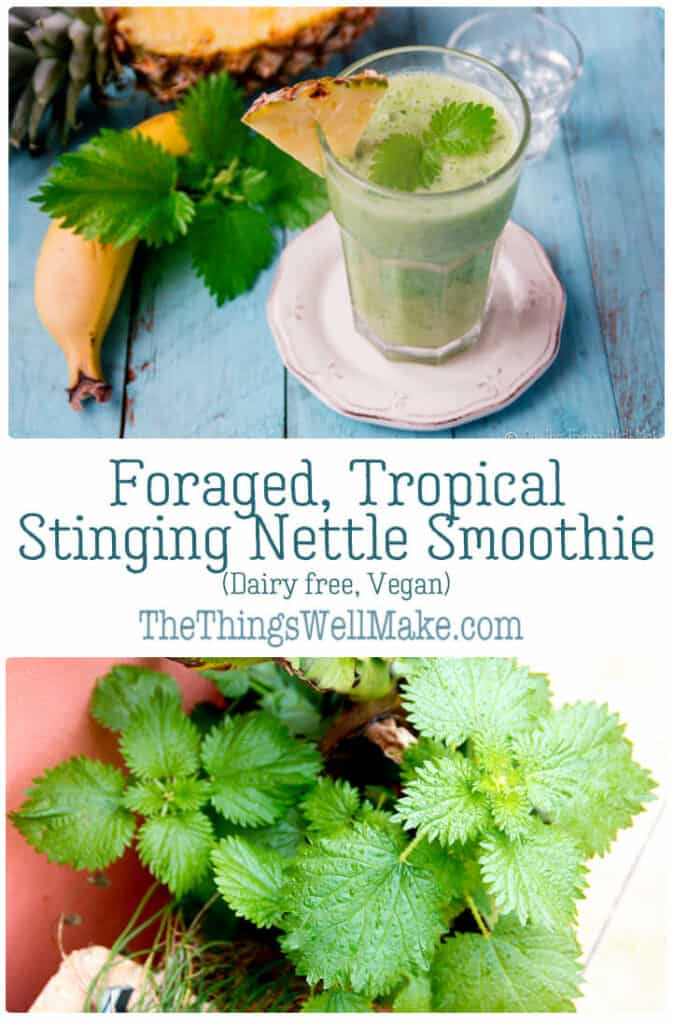
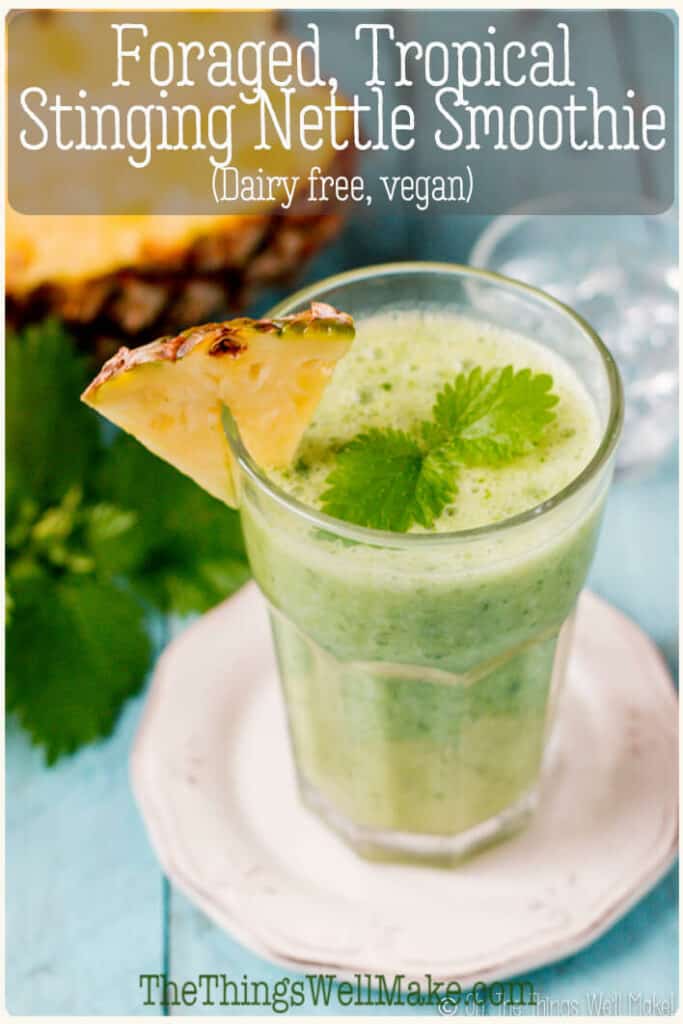
 Surprising Ways to Use Stinging Nettles (With Recipes)
Surprising Ways to Use Stinging Nettles (With Recipes)
Peggy Dunn
You may want to rethink nettles being low oxalate. Here is a recent paper where they tested the oxalate content of nettles from various locations. The leaves are the extremely high in oxalate
International Journal of Food Science and Nutrition http://www.foodsciencejournal.com
ISSN: 2455-4898
Received: 22-07-2021, Accepted: 07-08-2021, Published: 23-08-2021 Volume 6, Issue 4, 2021, Page No. 111-116
Nutritional and anti-nutritional profiling of stinging nettle (Urtica dioica L.)
Tracy Ariza, DDS
Hi Peggy,
Thank you for the information. I’ll take a look at it later. I did an extreme amount of research on it when I first wrote this, but couldn’t find very much information. This appears to be a new study, so I’m really interested in seeing what they have to say!
Ally
Are there any weeds in the UK that can’t be thrown in the blender and drank as a smoothie?
Thanks!
Tracy Ariza
Hi Ally,
I’m sure there are some that you’d want to avoid, so I wouldn’t just throw anything in your smoothie without knowing what it is, just in case.
Lambs quarters, nettle, dandelions, chard, and purslane are all common weeds here in Spain that you can definitely add to your soups, smoothies and salads, though.
Andrea Reid
Thank you for all this great insightful information. It is very helpful info. A couple things you may want to look into though is the effect nettle can have on hormones, particularly testoterone. Not sure if it would affect your son or not, but altering hormones can be dangerous. Another thing to look into is the effect nettle can have on your heart rate. It can act like a calcium channel blocker and slow/lower your heart rate. It can also cause vasodilator of blood vessels which lowers blood pressure which might be good for someone with high blood pressure, but could be bad for a healthy person or a child. Thanks again. God bless you you Tracy
Tracy Ariza, DDS
Thanks for the tips, Andrea!
I’ll look into it. We only have one or two each year, so I’m not too concerned. (I do make myself teas from the leaves I dry occasionally. I do have low blood pressure anyway, and haven’t noticed any major drops, but I can try to keep an eye out in the future!)
J W
My family and I have been eating nettle smoothies for a couple of years now, ever since moving to some property that grows forests of nettles. I think nettle had a fresh, tart flavor. There is a way to even pick it and eat it raw, though I haven’t mastered the picking with bare hands part. It has to do with the fact that the needles only point one direction. If you brush them a certain way, it breaks them off and you can eat it then and there. I stung my fingers doing it but was able to eat some without stinging my mouth and they taste amazing! No wonder the plants have to protect themselves so viciously- or everyone would be eating nettles instead of lettuce!
Tracy Ariza
Hahaha, JW!
So true. I wish the nettles had a longer season for using raw. They really are great.
Thanks so much for your comment- it’s really interesting. I’m not very good at picking them bare handed either. 🙂
Richard-Margie Druery
We have been using nettle leaves raw straight away young and old plants snipping the tops mostly on older nettles since 1988. We freeze and dry them as well for wintertime green smoothies. We use all kinds of wild greens. The Indians used to eat curly dock leaves like spinach all the time so in they go into the Green Smoothie as well. Purslane anyone use wild purslane? This is another top drawer plant for the basket mix for Super Green Smoothie recipe.
Don’t let the K-nine dog rumors scare you off. We have seen fields of greens being harvested and the fiber glass outhouses are way on the other side of the huge fields. The pickers are on piece rate and don’t have the time. The fiberglass outhouses are there for show.
Wild edibles and your own garden is way………………….
Tracy Ariza
Yes, there are a lot of great wild greens that can be used. I really like lambs quarters too. We also have a bunch of them growing wild in my yard.
I still need to try purslane. I’m not quite sure why I haven’t tried it yet as we have it growing within my vegetable garden. I’m pulling it up all of the time. I think the “juicy” appearance has always scared me off somewhat, but I promise to try it next time I weed the garden. 🙂
Dale
Purslane has too much oxalate content to be useful in your diet.
Tracy Ariza
Thanks for your comment, Dale!
That’s interesting!
I have to admit that I still haven’t gotten around to trying more than a tiny bit of purslane. I keep setting some aside to try making a salad or something with it, but never get around to actually doing it. I had always read that purslane was a wonderful weed for eating, but haven’t done a lot of research on the subject because I haven’t wanted to post anything with purslane in it yet. I’ll have to look into it more.
John
Any news on the next nettle post? I’m looking forward on the further discussion on harvesting and processing the nettles safely.
Tracy Ariza
Hi John,
Ah, yes, thank you for the reminder. I sort of put it off because this post didn’t seem to be very popular, and I didn’t think there was much of an interest anymore. I did ask some of my blogger friends for some of their posts to bring together lots of information. I just never put it together. Perhaps I should revisit the idea.
Susan Lance
Thank you for all the info. I am making foraging smoothies. I will try this one??
Tracy Ariza, DDS
Thanks, Susan! I hope you enjoy it!
Martha
I’ve been foraging wild nettles recently too here in the UK, and also making nettle infusions a la Susun Weed (instructions online!) which have helped my energy levels rocket! It’s astonishing. Thank you for your lovely recipe and reaching out to share wisdom with us all! xxx Martha
Tracy Ariza
Hi Martha,
Yes, I love nettle infusions too. I dried out quite a few from my garden this year so I could add them to other herbal teas! 🙂
I’m so happy to hear that they’ve been helping you!
Jen
Nettles contain oxalic acid as well. Though the concentrations are especially high in older leaves, the young spring shoots still contain some. It is pretty irresponsible to suggest they’re some kind of miracle alternative to oxalate containing greens. Just like spinach, etc, the concentration of oxalates in nettles depends on the age of the leaves. Young ones are always preferable.
Tracy Ariza
Hi Jen,
Thanks for your comment.
At the time of writing this post, I had done a lot of research about it and couldn’t find much information about the oxalic acid content of the raw nettles. The tea itself is always listed as an approved food in any quantity for people on a low oxalates diet. The raw nettle leaves themselves are rarely mentioned, and within the small amount of information out there, it tends to be conflicting. Not only that, it isn’t always about the amount of oxalates in a food, it really depends a lot on the soluble oxalate content vs. the insoluble oxalate content of a food. (I can’t find any great information sources about nettles in that regard.)
I have only found one source that did say that nettles themselves were high in oxalates, but it didn’t mention which sort of oxalate, and only said that the oxalates in those foods would contribute to crystal formation in the kidneys. That seems to conflict with most of the information out there about nettles that say that they help dissolve kidney stones and that they can help reduce oxalates in the body.
Here are some other sites that mention the nettle/oxalate topic:
Gaiaherbs: (Link removed Oct. 2019 as it is now a broken link.)
I was going to link to more sources, but just a quick search will show that nettles are often cited as a cure, rather than a cause, of kidney stones.
I’m happy to update the post with the fact that there is conflicting information about the amount of oxalates in the leaves themselves, but I personally don’t believe that nettles are a risk factor in the formation of kidney stones. That said, it is important that each person inform themselves and make their own decisions about what they will try for themselves. I agree that it is best to stick with young leaves, which is why I suggested people choose those when I wrote the post.